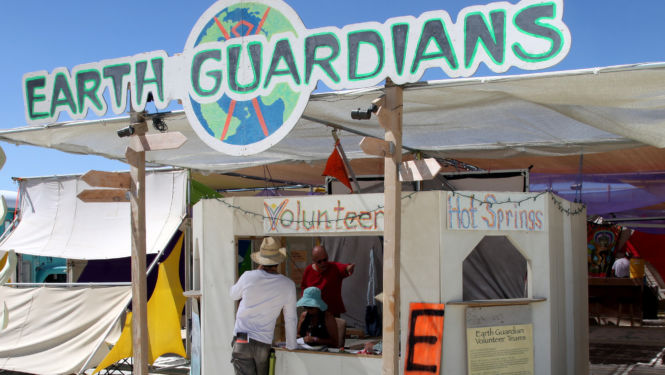Which of Burning Man’s 10 Principles is the most important? Hmm. Without Radical Inclusion, would we feel welcome? Without Radical Self-expression, would the art suck?
Without Leaving No Trace, would there be an event at all? Nope. The Black Rock Desert land owner (that would be the United States) requires that we leave no trace. If we leave a trace, we don’t get invited back to play. By power of reasoning, we could argue that Leaving No Trace is the one principle that is absolutely mandatory.
“Aww, man!” you might be thinking. “I wanted to read about Immediacy! And Participation! Leaving No Trace is so … well … pedestrian!”
Like watching the last campmates drive off Monday morning after the Temple Burn while stuck picking up those last little bits of MOOP, sporting the worst hangover ever, perhaps?
OK, but what Leaving No Trace might seem to lack in glamour it actually makes up for in ultimate cosmic magic: an entire vibrant city assembled and then taken down again without a trace. Invisible! Visible! Invisible!
Here! Poof! Gone! In that, Leaving No Trace outshines them all.
Behind most magic, though, lies a whole lot of tenacity, ingenuity, and old-fashioned elbow grease. Since Burning Man made its home in the Black Rock Desert in 1990, the efforts of thousands of Burners have woven Leaving No Trace principles deeply into the fabric of our ethos and our culture.
From the beginning, Burning Man participants “packed it in and packed it out,” but 1998 was a watershed year in the Black Rock Desert. Burning Man formally adopted the “Leave No Trace” principles, borrowing the phrase from the United States Forest Service, the Bureau of Land Management, and the National Park Service, which coined it in a widely circulated brochure the late 1980s.

Nature Walks focus on LNT, playa dynamics, ecology and geology with the field trips lead by experts in native biology and geology. (Photo by Karina O'Connor)
Earth Guardians formed in 1998 to inspire, inform and encourage people to embrace LNT principles. Recycle Camp became an official Theme Camp.
In 1998, Recycle Camp and collected about 20,000 aluminum cans. Today, Recycle Camp collects about 200,000 cans a year and donates the proceeds — $1,500 in 2015 — to the Gerlach K-12 school.
Since the late ’90s, Burners have rolled out a cavalcade of programs, practices and traditions to make Burning Man a more eco-friendly event. Train the trainer events. Highway cleanup. Hot springs patrols. The trash fence. Oil drip awareness and surveys. Sensitive ecosystem restoration. Collected helpful hints for greening your camp. Gray water disposal evapotrons. Picking up MOOP on a hot dusty, windy day.
But what about the “invisible MOOP” — such as air pollution and greenhouse gases — that Burners generate on-playa and on their way to the desert? We have practices for that, too: Solar instead of gas-powered electrical generation. Carpooling and alternative transport instead of So Many Cars. Experience over possessions. But anybody who’s been out there knows there’s a LOT more we could all do on that front.
Just as early Burners pitched in to make Burning Man a model Leave No Trace event, we present-day Burners have a huge opportunity before us to practice Civic Responsibility and Participation (yep, more of our 10 Principles) in Leaving No Invisible Trace. Cosmic!
Top photo by Steven Fritz


The two LNT practices I would like to see added to the LNT communications are: a) moop your camp site as soon as you arrive. Start with a much cleaner baseline. We do and find 10 to 20 pieces of moop in a 100 sq ft area every year, and 2) pick up objects that loo lost, like they belong to someone, because they do, and bring them on down to lost & found at Playa Info,
Report comment
LNT is the only principle that is negative, as in “NO”. And it’s the only one that came later. All the other ones are observations of what the culture is. They are guiding principles. LNT is a rule. Not a principle. None of the other principles are rules. You are not required to do any of them. Your actions won’t be frowned upon. They are guiding principles.
Decomodification is another “NO” principle but it’s not a rule. It’s something everyone lovingly adheres to.
And in that note I have some fun comments about MOOP. 1 – aren’t we all MOOP, specially on the playa? 2 – MOOP is the only thing that doesn’t fit into “radical inclusion” :) 3 – I think we should start a movement to make MOOP inclusive. Love thy MOOP :) and take care of it.
Report comment
MOOP is everything which is not the desert. So yeah, the RVs and tents and art and of course we the people are all MOOP.
Report comment
Comments are closed.